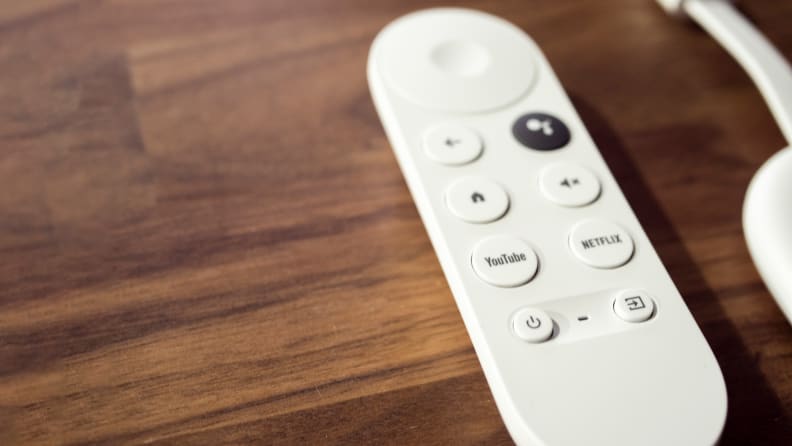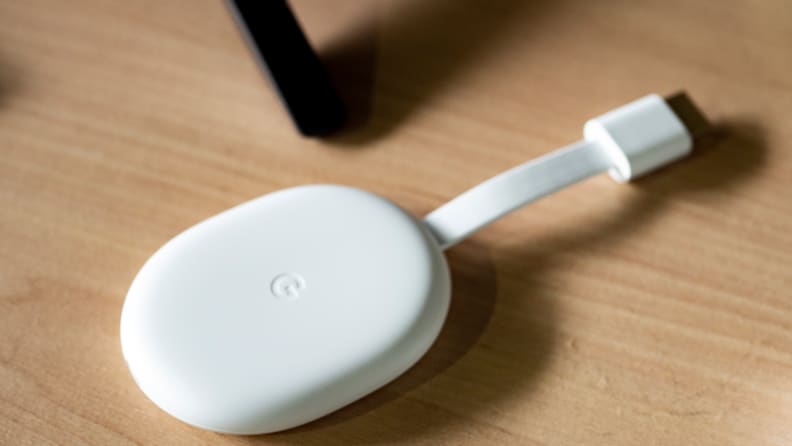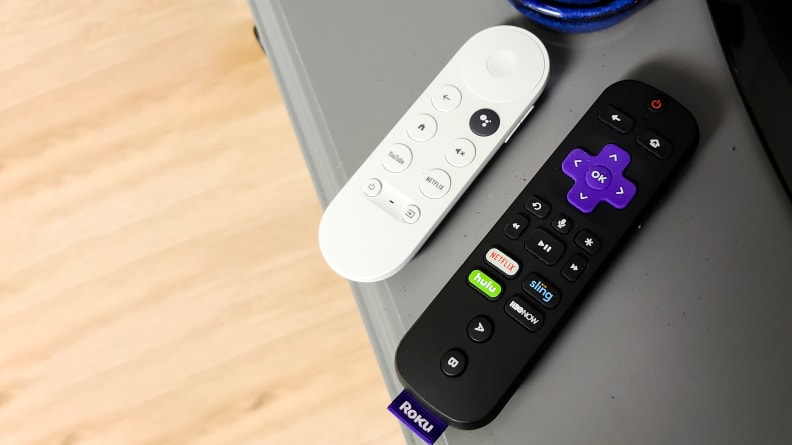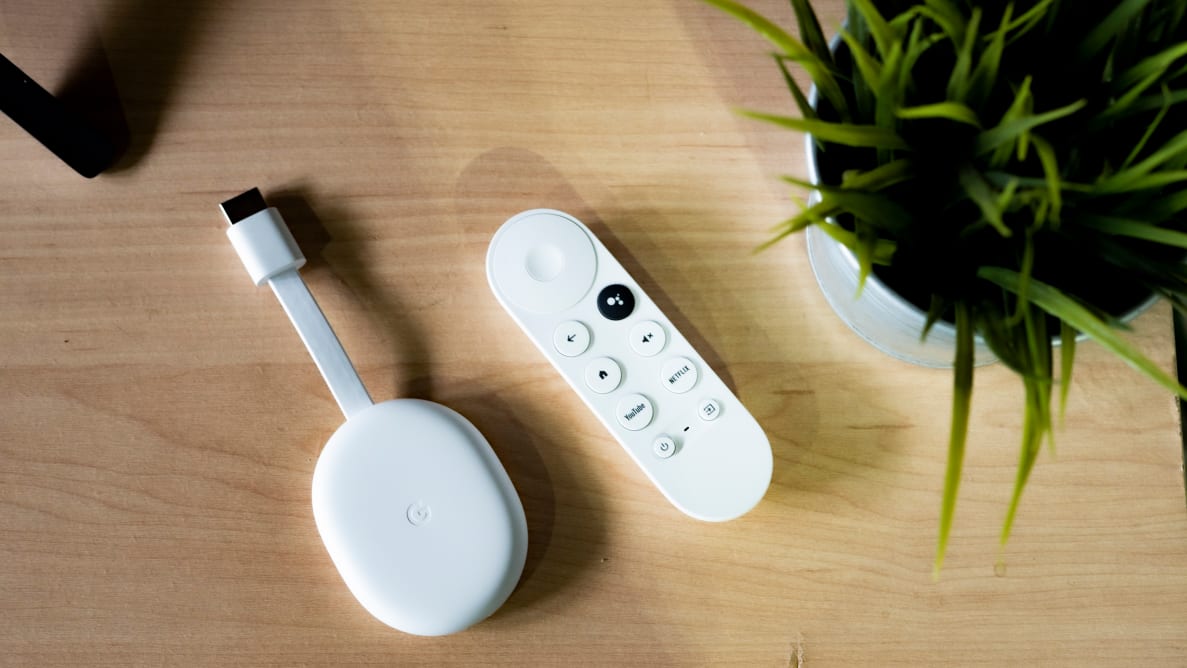Pros
-
Affordable
-
Very good remote
-
4K/HDR Support
Cons
-
No wired internet
-
Interface needs work
Updated July 25, 2022: This post has been updated to reflect the latest information and software updates.
In some ways, it's interesting to see Google pivot from its well-established "Chromecast" designs, which are largely geared toward tech-savvy consumers that occasionally want to send some content from their phone to their TV. This new model keeps the Chromecast branding, but totally changes the user experience. This is a much more traditional streaming device, clicker and all.
It's not the first time Google has tried this type of standalone design, but it enters a much more mature streaming market. The idea of a box that just streams video from the internet is no longer weird, and Google has the benefit of its own hardware optimizations and seeing the mistakes being made by its competition. Google seems to have been paying attention to its competitors' missteps, though it makes some of its own mistakes along the way.
About the Chromecast with Google TV
The Google Chromecast with Google TV is a standalone streaming box, running a rebranded version of Android TV that Google has dubbed Google TV. You'll find the same operating system on some of the best TVs out there.
Here are the Chromecast with Google TV's specifications according to Google:
Operating System: Android TV OS (Google TV) Resolution: Up to 4K/HDR at 60fps HDR Formats: Dolby Vision, HDR10, HDR10+ Audio Formats: Dolby Digital, Dolby Digital Plus, Dolby Atmos (pass-through) Connectivity: HDMI out, Bluetooth, 802.11ac (2.4GHz / 5GHz) Wi-Fi, USB-C for power Remote: Voice Remote Colors: Snow, Sunrise, Sky Weight: 1.9oz Dimensions: 2.4 in x 6.4 in x 0.5 x (W x L x H)
As you'd expect, the latest Chromecast plugs directly into the HDMI port on the back of your TV. It has a USB-C port for power that you have to plug into a wall outlet or power strip (your TV's USB ports likely don't provide enough power), and it connects to your internet via Wi-Fi.
Previous Chromecast models worked the same way, but once you connected it to your Wi-Fi and plugged it in, there wasn't much else you could do with it by itself. Instead, when watching content on another device (like your phone), a Chromecast logo would appear that you could tap to "cast" the content onto your TV screen.
This is entirely different, offering a full-blown Android TV experience, complete with a remote, menu, apps, file management, and an app store. You can still use it like previous Chromecasts, but it no longer requires another device to be useful.
What We Like

The Google Chromecast with Google TV interface puts content front and center, but doesn't favor Google's apps too heavily.
The Google TV experience is a long overdue addition
Google's product strategy has always been "throw things against the wall and see what sticks," but particularly in the TV space. On the hardware side, it had the Chromecasts. On the software side, it had Android TV. Two very popular products you'd think would go great together. And yet, it took seven years for Google to marry them.
The result is simply great. It's easy to use, fast, and has access to nearly all the apps you could ask for. The addition of a remote and a full menu system and user interface makes it much easier to use the Google Chromecast in a home with people who are less tech savvy or don't have their own separate devices (like kids).
Compared to Roku, Amazon Fire TV, and Apple TV, the user interface is refreshingly simple. Despite Google being the largest provider of ads on the planet, its latest offering is relatively low on ads, instead focusing on shuttling you to the apps you want. The one service Google features more prominently than others is its own YouTube and YouTube TV, though it doesn't dominate the interface the way Apple, Roku, and Amazon do with their own offerings. Google seems to have settled for putting a dedicated button on the remote, which is very convenient if you use YouTube TV and reprogrammable if you do not.

The Google Chromecast with Google TV's remote is slick, but it has just enough buttons to satisfy most uses.
The remote is a great addition—even if it needs some work
Speaking of the remote, Google did a great job of borrowing what works on remotes from its competitors. It has a clicky control pad like Amazon and Roku, dedicated buttons for specific streaming services, a dedicated mute and home button, as well as volume controls right on the remote itself. I'd say it's a bit better than the Amazon Fire remote (thanks to the dedicated Netflix button), but it's still a far cry from what Roku delivers.
We'll nitpick the remote's flaws a bit down below in the "What We Don't Like" section, but in general it gets the job done beautifully. It even includes an IR blaster, letting you control IR-ready devices that other wireless remotes cannot. It's a great first effort for Google, and it more than gets the job done.
Android TV is as simple or complex as you want it to be
While the rebranding of Android TV to "Google TV" on this Chromecast is a bit confusing, the interface itself is anything but. Boot up the Chromecast for the first time and you'll be prompted to set things up either on your phone with the Google Home app or on your TV with the remote. Either way is pretty straightforward, though you'll want to know your Wi-Fi password and Google account password.
During setup, you're given the chance to say which apps you want (though some are loaded by default), but there's also an app store you can access to find other apps that are Android TV compatible. The home screen works largely like the home screen on Netflix, Apple TV, and Amazon Fire TV, with a large splash image at the top with content suggestions and horizontal rows of content and apps that changes depending on your viewing habits and installed apps.
The splash screen seems to rotate through the most popular content from your favorite apps. So on my Chromecast, I'm greeted by suggestions from YouTube and then it rotates to Netflix, HBO Max, Amazon Prime, etc. This is prime real estate, so it's noteworthy for Google to cede it to its closest competition. It's great for users, so it's nice to win that battle for once.
It's worth noting that, like other streaming devices, you'll still need to log into all your preferred apps after setup. Even though you may have those app passwords saved in your Google account, they won't transfer over to the Chromecast automatically. When you log into an app for the first time it does give you the option to skip logging in and go right to "casting" content from a phone, but as soon as you stop casting it'll ask you to log in again.
Voice search is fast and accurate
Like all other streaming boxes now, Google offers you the option to search for content with your voice, in this case using Google Assistant. There's a dedicated button on the remote and you just need to hold it down and start talking to search for something to watch. It works very well, looking across apps to see if you have access to matching content on an existing subscription like Netflix before offering you the option to rent or buy it.
Though the Chromecast does ostensibly feature Google Assistant for this, it's not as capable as Google Assistant on a Google Home or similar smart device. There is likely more functionality coming, but the Chromecast couldn't do simple things like set alarms when I tested it. Given the Chromecast's primary focus is on content, it's important that Google nailed that part first, but it's quite a bit less capable than the Alexa integration on a Fire TV Stick, for example.

The Google Chromecast with Google TV is similar to streaming sticks in terms of size, but it packs a punch.
The price is definitely right
The Google Chromecast ecosystem has always offered excellent value—even the more expensive Chromecast Ultra was a bargain compared to other HDR-ready streaming devices when it debuted. The market has changed quite a bit, with Roku and Amazon both offering 4K- and HDR-ready streaming devices for well under $75.
The Chromecast with Google TV starts at just $49.99, which puts it right in line with Amazon's Fire TV Stick 4K (also $49.99) and the Roku Streaming Stick 4K (even cheaper). All support 4K and HDR (including Dolby Vision).
In truth, all of these devices are very similar. There are minor differences, but how much they sway you in one direction or another mostly comes down to personal preference. If you like Android, the Google Chromecast is clearly a better value. If you like Alexa, go with Amazon. If you prefer Roku's superior remote, the Roku Streaming Stick 4K is the clear winner. At the very least, you're paying about the same, whatever your preferences.
What We Don't Like

Google Chromecast with Google TV's remote is smaller than the Roku's
The remote needs some work
I really like Google's approach with the remote. It has a four-way clicky directional pad on top, just enough useful buttons down below, and dedicated apps for the most popular apps, Netflix and YouTube. I like the IR blaster, letting it control power and volume even on older TVs—meaning this could sub in as your only remote. It's a great start, and it proves that Google at least understands what people want in a remote.
The execution needs to improve a little bit, though. The remote itself feels really lightweight, and the buttons have a very hollow-feeling click mechanism. My biggest issue with it is the shell is just too slick, making it very difficult to open the compartment to put new batteries in. That won't be an issue too often, but it's frustrating nonetheless.
The software still has some bugs to work out
Even though the Chromecast branding has been around for a while, there are always hiccups with a first-gen product. I didn't notice anything major in my time with the device, but there were a few times where things loaded incorrectly, a menu got stuck between two options, or I just needed to reset the device.
There are also some missing apps that we would like to see Google rectify shortly. The most obvious one is the Apple TV app. If you currently use Apple TV to tie all your streaming subscriptions together, or even just to manage an iTunes library, you can't access it on this Chromecast yet. You can use the Apple TV+ service on Chromecast, though. You just have to sign up through Apple first, then download the app on your device from the Google Play store.
Tighter integration with Google would help
Despite being a Google-made product with Google branding all over it, there was remarkably little of the Google ecosystem that spilled over onto the Chromecast. I frankly expected a creepy level of readiness when I booted up the Chromecast and logged in.
I don't need to be greeted with trivia about my deepest fears or ads for a thing my friend and I talked about two days ago, but I would like to at least have my Netflix credentials carried over without having to type them all in again. The setup is so quick and clean that having to immediately put in 8 different passwords is a drag. If I'm going to opt into a technocratic surveillance state nightmare at least save me five minutes.
This branding is going to give me a headache
The "Made by Google" Google Chromecast with Google TV is, frankly, an insane choice for a product name. What was wrong with calling it the "Chromecast with Android TV"?
I get that Google wants to signal that it's serious about being a streaming TV player, to the point that it wants to put its name on everything. It even renamed the "Android TV" operating system "Google TV."
Of course, it gets worse. Google has also rebranded its "Play Movies" app, which is the app on Android phones where all your movie rentals and purchases are stored. The new name? Google TV. (The sound you heard is me throwing my phone across the room)
It takes a special kind of company to rebrand two completely different, successful products—Android TV and Google Play Movies—to the same thing—Google TV. I just... I don't get it. This is like George Foreman naming all five of his sons "George." Is this a bit?
If it feels like the Google Chromecast with Google TV by Google is Google trying a little too hard to rebrand itself as a media company, well, you haven't used Apple TV+ on the Apple TV app on the Apple TV 4K. Seriously, stop. Nobody is going to forget who Google and Apple are.
You win. Cut it out.
Should You Buy It?
Yes—but consider the alternatives first
As much as I love the Chromecast, it's always been little more than a polished side project for Google. The whole "casting" concept is great, but it's better as the side dish, not the entrée. The addition of a remote and a full operating system makes the Google Chromecast with Google TV so much more. It's very nearly everything we want in a streaming device.
It's fast, responsive, has a very promising remote, and it supports nearly every major 4K/HDR format you might care about. The software is easy to use, doesn't play favorites between streaming services, and it features an awesome voice search function to tie it all together. Oh, and it's only $50.
Its closest competitors are the Amazon Fire TV Stick 4K and the Roku Streaming Stick 4K. All three are similarly priced (though go on sale frequently), offer 4K and HDR, and have access to pretty much every streaming service on the market. The Fire TV Stick 4K is only worth it if you use Alexa a lot and don't have an Echo in your living room already, otherwise, it's between the Roku and the Chromecast.
In truth, it's a virtual tie between the two. The Chromecast wins points for Android (including the ability to sideload apps for you tech-savvy folks) and its remote's IR blaster. For everyone else, the Roku is the better choice thanks to the better remote and the inclusion of Apple's TV app. Roku also tends to put your apps front and center instead of immediately recommending content, which I think is cleaner and simpler for beginners to master.
That said, Google has a winner on its hands here. The Chromecast with Google TV isn’t just a great value, it’s one of the best streaming devices you can buy, period.
Meet the tester
TJ is the former Director of Content Development at Reviewed. He is a Massachusetts native and has covered electronics, cameras, TVs, smartphones, parenting, and more for Reviewed. He is from the self-styled "Cranberry Capitol of the World," which is, in fact, a real thing.
Checking our work.
Our team is here for one purpose: to help you buy the best stuff and love what you own. Our writers, editors, and lab technicians obsess over the products we cover to make sure you're confident and satisfied. Have a different opinion about something we recommend? Email us and we'll compare notes.
Shoot us an email






